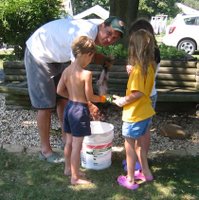Well our new chicken coop that seemed huge when I first built it is starting to get crowded with the nearly 60 chickens which currently call it home. This along with the fact that the cockerels are nearly as big as our two and a half year old hens meant that we needed to start thinking about culling some of the cockerels. Since I have never processed a chicken before and I was going to do this by the book (i.e. no one was around to walk me through it) I decided to start small and just process one chicken. I isolated a Dorking cockerel in the morning and set him up with just water. I know you are supposed to do this overnight but I did not plan that far in advance. As it turned out I ended up butchering a different Dorking (one that got out of the chicken pen and into our yard). He was a real pain to catch so it seemed like as good a chicken as any to cull from our flock.

I built a killing cone from an old gallon milk container by cutting open the bottom and opening up the spout enough for the chickens head to poke through. With an old spackle bucket below to catch the blood I cut the chickens jugular and let it bleed out. I also de-brained it, which according to the books is supposed to make the process of plucking the feathers easier. After the chicken was done bleeding I scalded it for 30 seconds in hot water then the kids and I began plucking the bird. All and all I have to say that dealing with the feathers was the most time consuming part of the entire operation. While it was not hard to pull out the feathers, there just always seemed to be more of them.
Once the bird was as free of feathers as it was going to get it was time to eviscerate the chicken.
 While this sounds daunting in the books, all you really are doing is cutting off the feet and head and removing the guts. Considering I did not really know what I was doing it all went smoothly. I was amazed by the size of the liver, it was by far the largest organ. I removed all the giblets and offal and disposed of them. In the future I will probably at least save the livers to make pate, but for my first run I just wanted to keep it simple. After washing off the bird and putting it in the fridge to cool I cleaned everything up and had a beer.
While this sounds daunting in the books, all you really are doing is cutting off the feet and head and removing the guts. Considering I did not really know what I was doing it all went smoothly. I was amazed by the size of the liver, it was by far the largest organ. I removed all the giblets and offal and disposed of them. In the future I will probably at least save the livers to make pate, but for my first run I just wanted to keep it simple. After washing off the bird and putting it in the fridge to cool I cleaned everything up and had a beer. After relaxing for a while I fired up the grill and put some red potatoes on to roast.
 We made beer can chicken and grilled up some Gold Nugget tomatoes as well. Everyone except Sam tried some of the chicken.
We made beer can chicken and grilled up some Gold Nugget tomatoes as well. Everyone except Sam tried some of the chicken. It had a lot of flavor but was a bit chewy. Not sure if this is the norm for free range birds or just cockerels. The neatest thing about dinner was that everything we ate came from our farm. The chicken, potatoes and tomatoes were all raised or grown on our farm. Even the rosemary and thyme came out of our kitchen garden. Danielle and I have been talking for some time about how great it would be to have an entire home grown meal, and I must say it was quite a treat.

The cockerel was on the small side so the rest of the flock has received a temporary reprieve, but in a couple weeks I will have to start processing the birds on a larger scale.





No comments:
Post a Comment